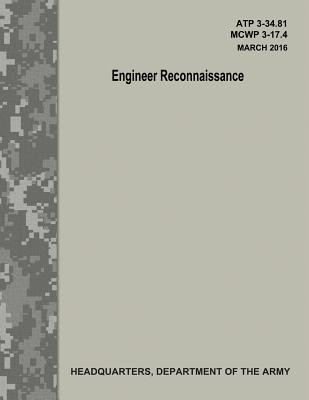
- We will send in 10–14 business days.
- Author: Department of the Army
- Publisher: CreateSpace Independent Publishing Platform
- Year: 2017
- Pages: 166
- ISBN-10: 1548717797
- ISBN-13: 9781548717797
- Format: 21.6 x 28 x 0.9 cm, softcover
- Language: English
- SAVE -10% with code: EXTRA
Engineer Reconnaissance (ATP 3-34.81 / MCWP 3-17.4) (e-book) (used book) | bookbook.eu
Reviews
Description
The three engineer disciplines are combat (with the capabilities and activities of mobility, countermobility, and survivability [M/CM/S]), general, and geospatial engineering. These disciplines include significant reconnaissance capabilities. The three engineer disciplines include extensive discussion on integrating the planning for, and conduct of, engineer reconnaissance support within the tactical operations of the combined arms team. This publication discusses the capability resident within combat engineer units to form and employ engineer reconnaissance teams (ERTs). It also describes the capability resident within general engineer elements to form and employ ERTs, augment combat engineer ERTs, or provide assessment and survey teams. Finally, geospatial engineering enables reconnaissance and may play a large role, especially during the planning process. Engineer reconnaissance, like chemical, biological, radiological, and nuclear (CBRN) and other technical applications, is not a form of reconnaissance. Engineer reconnaissance is a focused application of special or unique capabilities supporting reconnaissance, and it is applicable to all forms of reconnaissance. The engineer disciplines provide reconnaissance capabilities that vary in linkages to warfighting functions, degrees of technical expertise, and effort applied to the assigned mission and tasks. Engineer reconnaissance is directly linked to geospatial intelligence because combat and general engineer units use technical measuring or survey devices to confirm, correct, or update the accuracy of available geospatial information. After analysis and comparison against other intelligence collections, this updated geospatial information becomes intelligence, which feeds the commander's decisionmaking process. The engineer contribution to operational success is highly desired by the commander. Demands for engineer reconnaissance support will often exceed capabilities. These capabilities are spread thin, and they compete with the commander's needs for other engineer applications. The same engineer elements and capabilities are often required for each of these areas. Resolution of these competing priorities is one of the goals of the planning process. The staff-running estimate is created during mission analysis, and the engineer staff planner identifies the specified and implied engineer tasks (more than M/CM/S) and their associated purposes. This results in the recommendation of essential tasks for M/CM/S to the supported commander. Finally, this publication is written with the acknowledgement that the operational environment is more variable now. Engineers must be prepared to go into any operational environment and perform a full range of reconnaissance tasks in support of the maneuver commander while dealing with a wide range of threats and other influences. It builds on the collective knowledge and experience gained through nearly a dozen years of sustained military operations and exercises. It is rooted in time-tested principles and fundamentals, while accommodating new technologies and diverse threats to national security.
EXTRA 10 % discount with code: EXTRA
The promotion ends in 20d.08:25:36
The discount code is valid when purchasing from 10 €. Discounts do not stack.
- Author: Department of the Army
- Publisher: CreateSpace Independent Publishing Platform
- Year: 2017
- Pages: 166
- ISBN-10: 1548717797
- ISBN-13: 9781548717797
- Format: 21.6 x 28 x 0.9 cm, softcover
- Language: English English
The three engineer disciplines are combat (with the capabilities and activities of mobility, countermobility, and survivability [M/CM/S]), general, and geospatial engineering. These disciplines include significant reconnaissance capabilities. The three engineer disciplines include extensive discussion on integrating the planning for, and conduct of, engineer reconnaissance support within the tactical operations of the combined arms team. This publication discusses the capability resident within combat engineer units to form and employ engineer reconnaissance teams (ERTs). It also describes the capability resident within general engineer elements to form and employ ERTs, augment combat engineer ERTs, or provide assessment and survey teams. Finally, geospatial engineering enables reconnaissance and may play a large role, especially during the planning process. Engineer reconnaissance, like chemical, biological, radiological, and nuclear (CBRN) and other technical applications, is not a form of reconnaissance. Engineer reconnaissance is a focused application of special or unique capabilities supporting reconnaissance, and it is applicable to all forms of reconnaissance. The engineer disciplines provide reconnaissance capabilities that vary in linkages to warfighting functions, degrees of technical expertise, and effort applied to the assigned mission and tasks. Engineer reconnaissance is directly linked to geospatial intelligence because combat and general engineer units use technical measuring or survey devices to confirm, correct, or update the accuracy of available geospatial information. After analysis and comparison against other intelligence collections, this updated geospatial information becomes intelligence, which feeds the commander's decisionmaking process. The engineer contribution to operational success is highly desired by the commander. Demands for engineer reconnaissance support will often exceed capabilities. These capabilities are spread thin, and they compete with the commander's needs for other engineer applications. The same engineer elements and capabilities are often required for each of these areas. Resolution of these competing priorities is one of the goals of the planning process. The staff-running estimate is created during mission analysis, and the engineer staff planner identifies the specified and implied engineer tasks (more than M/CM/S) and their associated purposes. This results in the recommendation of essential tasks for M/CM/S to the supported commander. Finally, this publication is written with the acknowledgement that the operational environment is more variable now. Engineers must be prepared to go into any operational environment and perform a full range of reconnaissance tasks in support of the maneuver commander while dealing with a wide range of threats and other influences. It builds on the collective knowledge and experience gained through nearly a dozen years of sustained military operations and exercises. It is rooted in time-tested principles and fundamentals, while accommodating new technologies and diverse threats to national security.


Reviews